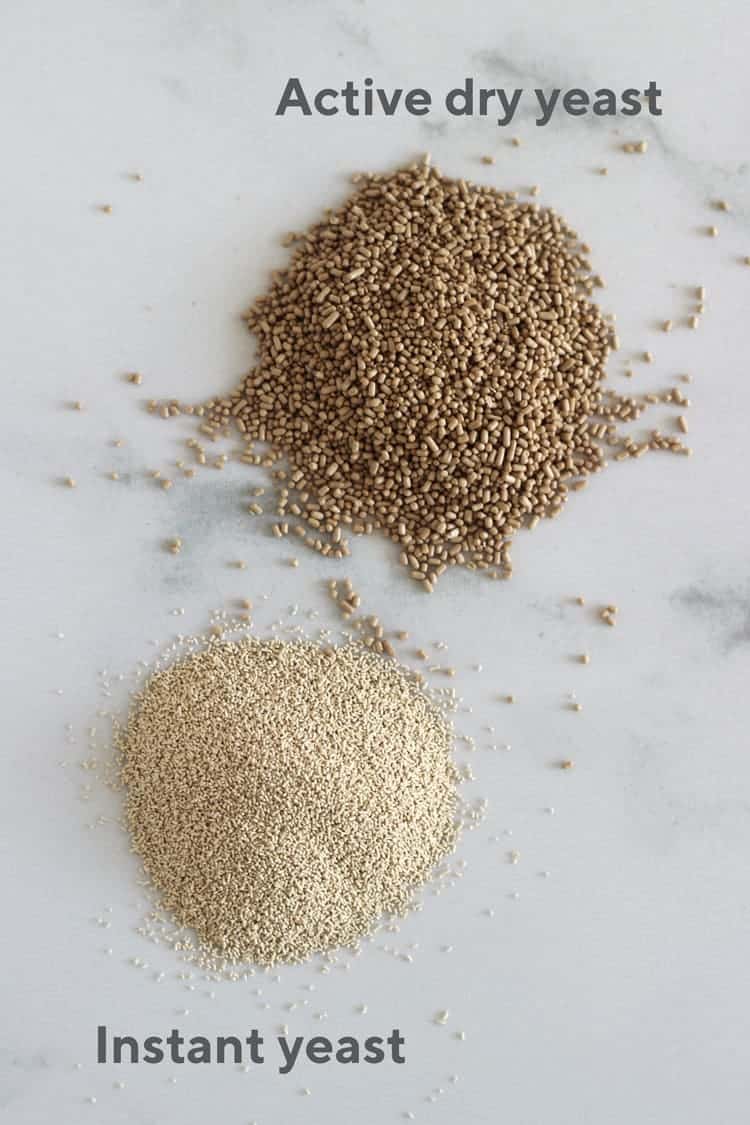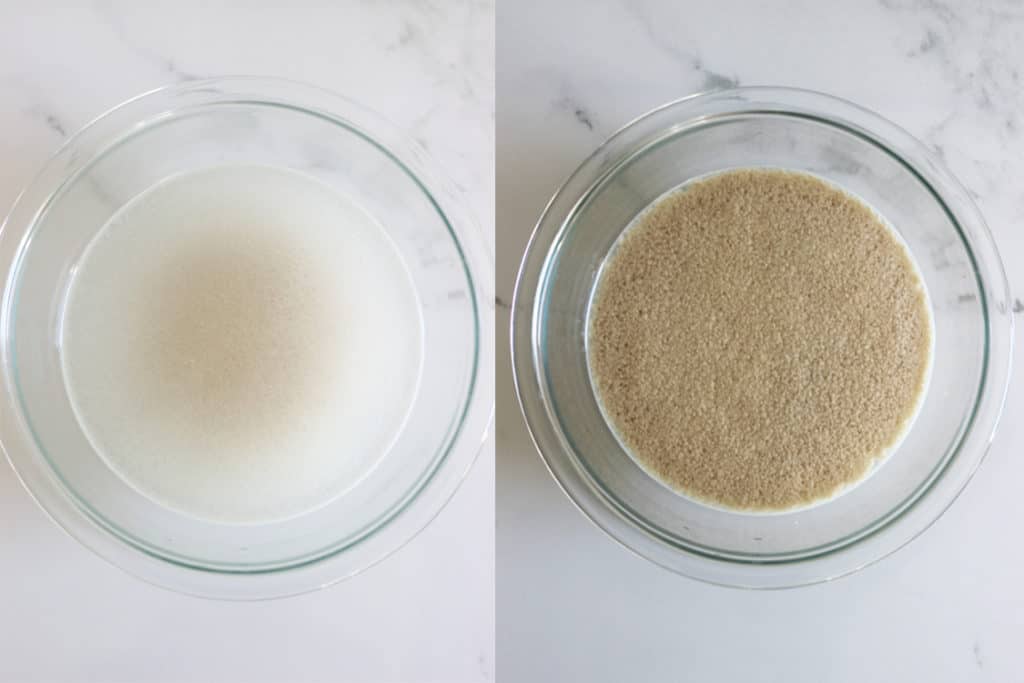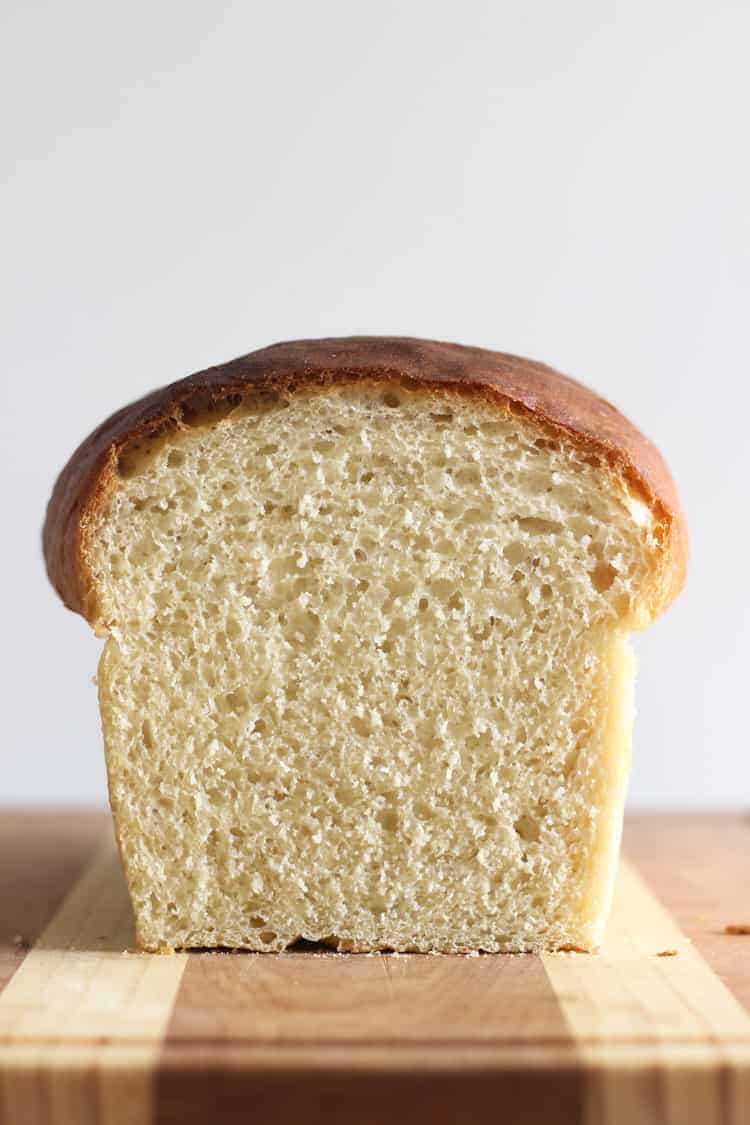Answers to commonly asked questions about baking with yeast. Reference this guide whenever you are baking bread or other dough recipes that require yeast and you will be a confident bread baker in no time!

Baking bread with yeast can be very intimidating but once you have a basic understanding of how it works, it's actually quite simple!
So let's get into it - I want this guide to be the place you come when you have any yeast baking questions!
What is yeast and how does it work?
To start with, yeast is a living organism. It requires food and water to thrive and converts that food (sugar) into alcohol and carbon dioxide through fermentation. The carbon dioxide gets trapped in the dough and makes the dough expand (rise). Yeast is also responsible for the flavour that comes along with yeast bread recipes.
Different types of yeast:
There are two main types of yeast that are used in bread baking recipes. Fresh yeast and dry yeast. Fresh yeast is what many bakers use and is not readily available to purchase. Dry yeast is what you buy from the supermarket and is what we will be talking about.
There are three main types of dry yeast:
- Active dry yeast
- Instant yeast
- Surebake yeast
Active dry yeast is granules of yeast. It needs to be activated (sometimes called bloomed) in warm water between 40-45°C/105-115°F before being added to the dry ingredients in a recipe.
Instant yeast is more finely ground yeast that can be added directly to the dry ingredients in a recipe without being activated. It also tends to rise faster than active dry yeast.
Surebake yeast is formulated especially for breadmakers and contains a mix of active dry yeast and bread improvers such as wheat flour and sugar which means there is a lower concentration of yeast in the jar.

Can I substitute active yeast for instant yeast or Surebake yeast and vice versa?
You definitely can. Use the following measurements:
1 Tablespoon active dry yeast = 1 Tablespoon instant yeast = 2 Tablespoons Surebake yeast
How do you activate active dry yeast?
Whisk together warm water (between 40-45°C/105-115°F) active dry yeast and a small amount of sugar and leave it for 5-10 minutes. The yeast should dissolve and start to bubble or foam. When this happens, you know the yeast is active and ready to use. If nothing happens and the water was the correct temperature, your yeast is dead. Throw it out and start again.

Do you have to add sugar or honey to activate yeast?
No you don't. Yeast will feed on the sugars in flour however adding sugar or honey to the water when activating the yeast gives it a nice boost. Sugar or honey do add flavour and are essential to some breads, especially sweet doughs like cinnamon rolls.
How should I store my yeast?
Store opened jars or yeast in the fridge or freezer. Unopened sachets of instant yeast are fine to store in the pantry.
How long does yeast last for?
Once opened, yeast should last about 4 months in the fridge or 6 months in the freezer (although I have had success using yeast I've had open for longer than this.
Yeast does have an expiry date so before you begin baking, check the expiry date on the jar of yeast (even if unopened). As soon as you buy your yeast, check the expiry date on the packet. If you are transferring the yeast into another container, write the expiry date on the container.
If it has expired or you are in doubt about if it is still ok, you can try activating the yeast. If it doesn't bubble and foam, throw it out and buy new yeast.
What is the best brand of yeast?
I prefer to use Edmond's yeast, simply because it's what I have always used with great results. Lately I have been using Bakel's instant yeast and I also really like that.
Is there a substitute for yeast?
Not a direct substitute. Some recipes for bread use beer or baking soda, however they will not rise exactly the same or have the same flavour as yeast breads.
Sourdough is also a great option for yeast free bread if you have the time and patience!
Where should I put my dough to rise?
Dough rises best in a warm environment - but not too warm! The first rise of the dough will always take an hour or two and you don't want to speed this process up or you risk over rising the dough or sacrificing the flavour that develops while the dough is rising. On your benchtop is fine (near a heat source if it is cold) otherwise try the following places:
- In the hot water cupboard
- On a sunny windowsill or other sunny spot in your house
- On top of the fridge or on a high shelf - heat rises
- In your car - this is often a warm spot!
- In the warming drawer of your oven - turn on the warming drawer and place the covered dough in the drawer along with a cup of water to keep the environment humid
- In the microwave - heat a cup of water on high for 2 minutes then place the covered dough in the microwave with the door shut
- You can heat the oven to low or just turn the oven light on, but as you need to heat the oven for baking during the second rise, I prefer not to use this method
- Using your multi cooker or instant pot on the yoghurt setting - you can put the dough to rise directly in the pot (covered in a tea towel) which does rise very quickly, or the method I prefer - place a baking sheet or chopping board on top of the pot and sit the bowl of dough on that - this provides a nice heat pad for the dough.
Can you rise bread overnight in the fridge?
Some doughs such as cinnamon rolls can do their first rise in a warm place, then shaped and put in the fridge to cold proof overnight, ready to be baked in the morning. They just need a good hour or two in a warm place once they've been taken out of the fridge before baking to rise again.
Pizza dough is also a good one for making in the morning and leaving in the fridge all day.
I wouldn't recommend leaving a loaf of sandwich bread in the fridge to rise but anything smaller - buns, rolls etc is worth a try after the first rise.
Why is my dough not rising?
If your dough is not rising, there could be several reasons for this:
- Yeast is expired - check the expiry date on the yeast and if it is old, start again with new yeast
- Temperature is too cold - dough needs a consistent, warm environment in order to rise
- Temperature of the water used to activate the yeast was too hot - if the water is too hot, it will kill the yeast. You want it to be around 40-45°C/105-115°F
- Too much flour or sugar added to the dough. Yeast needs just the right amount of liquid to rise effectively. Too much flour makes the dough dry - you want it to be tacky, and not too dry when kneading. Likewise, too much sugar and the sugar absorbs the liquid in the dough having the same effect. For this reason, sweet doughs often do take longer to rise than standard doughs, so keep this in mind.
- Salt killed the yeast - always add the flour to the yeast mixture before adding the salt as adding salt directly to the yeast mixture can kill the yeast
- The size of the loaf tin - if you are baking a loaf of white sandwich bread and it doesn't rise as high as you would like, it may be that the loaf tin you are using is too big. Longer, wider tins are still fine for baking bread, but just be aware that the loaf won't rise as high.
Can you leave dough to rise for too long?
Yes you can - if you leave dough to rise for too long, particularly on the second rise it will get to the point where it is no longer able to support itself and will collapse.
On the first rise you want the dough to double in size - the time in the recipe is just an estimate of how long it will take as there is so much variation seasonally and between kitchens, so make sure you keep an eye on the dough and move on to the next step once it has doubled.
The second rise typically doesn't take as long - for a loaf of bread you want the dough to be about 2.5cm (1 inch) above the top of the loaf tin, or for things like rolls and buns, they will rise and get puffier but won't necessarily double in size.

I hope you have found this guide helpful - if there are any questions I have missed, leave a comment below and I will update the guide to make it as helpful as possible!
Happy bread baking!



Colleen King says
I have a breadmaker and I've tried all sorts of yeast withg varying results. Before finding your web site I phoned Edmonds and the customer support person couldn't tell me the exact difference between Active and Surebake so I seperated out the yeast from the bread improvers in Surebake and it's definitely half and half. I've tried substituting Active yeast for Surebake at a raitio of 1 : 2 but I have never had any success in the breadmaker, I get a much smaller, and sometimes hard, loaf with Active yeast. Most breadmaker recipes seem to specify Active yeast without proofing first, so no idea how they get a good loaf. I always make a mixed grain loaf so it might just be that Surebake is best for that combination of ingredients.
Sonya says
Awesome tips on the uses of different yeasts, very helpful. I was thinking about trying surebake, but it seams best to stick to the usual one.
I think it’s important to note although sourdough doesn’t use added yeast it isn’t yeast free, the starter is grown from wild yeast and wild lactobacillaceae.
Thank you again for your advise on the yeast types.
mike says
I've been trying the Sure Bake Yeast Mixture and find that it is easier to work with than the Active Dry Yeast and the flavor is more even which is the only problem. But I must pic Sure Bake Yeast Mixture over the Active Dry Yeast for the ease of working with and thank you for the Tip of doubling up on the Sure Bake Yeast Mixture to my recipe.
Tracey says
I have been given a breadmaker for Christmas. I make my pizza bases normally using Annabel Langbeign recipe. They always come out perfect.
So now I am going to try and use the bread maker. The recipe calls for 1 fresh yeast block 25g.How much of Tasti's Active dried yeast for breadmakers would I use? I would appreciate your help! Many thanks from Tracey.
Or do you have a good recipe for pizza dough in a breadmaker?
Laura says
Hi Tracey! I don't have any experience making dough in a breadmaker but I would try my pizza dough recipe (or the one you usually use) on the dough setting in the breadmaker! I've never used a block of yeast either so would be unsure of the substitution for dried yeast sorry! Laura
Heilandri Moller says
hi does yeast need gluten to rise or can I opt to substitute flour with egg like cloud bred or cauliflower pizza base
Laura says
Hi there, yeast doesn't need gluten to rise but I definitely wouldn't recommend substituting flour with an egg! If you need a gluten free bread recipe, I'd do a quick google, there will be plenty of options out there. Not my area of expertise though sorry! Laura
Dani says
Hi just want to ask how do you use superbake yeast?
Do you activate it first and wait for it to be foamy before adding to the dry ingredients?
I tried that method but it didn’t turn foamy? And simply looked like it dissolve.
After 1hr it looked like the dough expanded but not the usual doughs that I see where you punch out air from it. I proceeded baking it and the dinner rolls were okay but I expected the inside to be fluffy? It was intact in the inside of the bread. So i’m not sure if I’m using the Superbake yeast correctly.
I also tried adding it directly to the flour but the dough didn’t rise so I just threw it away.
Thanks in advance! Your website is the only one I found that mentioned about using Superbake yeast for hand made breads. 🙂
Laura says
Hi Dani! I don't use Surebake yeast at all, simply because I find it a bit confusing haha! Make sure you are using double the amount that a recipe calling for active dry or instant yeast says and I would activate it first and wait for it to be foamy, just to be sure! If it's not foamy, make sure your water is warm enough and definitely make sure the yeast hasn't expired! Laura